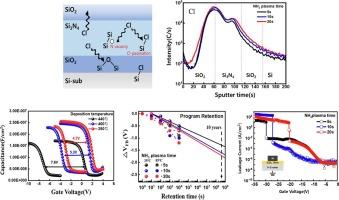氯对等离子体增强原子层沉积Si3N4电荷阱层MONOS器件记忆特性的影响
IF 6.9
2区 材料科学
Q2 CHEMISTRY, PHYSICAL
引用次数: 0
摘要
为了提高闪存的性能,需要对器件结构进行纵向和横向缩放。特别是,电池组件金属-氧化物-氮化物-氧化物半导体(MONOS)器件的有效缩小需要开发电荷捕获层(CTL)的沉积策略,并了解电荷损失机制和数据保留特征。在这项研究中,我们研究了氯(Cl)在MONOS器件中的影响,包括等离子体增强原子层沉积(PEALD) Si3N4薄膜作为CTL。为了评估Cl对CTL的影响,我们制作了不同Cl加入量的记忆器件,比较了实验条件,并分析了样品的记忆特性。定量分析CTL中Cl的产生原因。此外,通过电分析方法,如电容-电压(C-V)和泄漏电流-电压(I-V)方法,确保了记忆特性。我们已经证实了cl相关的陷阱具有较浅的陷阱水平,导致Si悬空键的钝化和抑制电子的捕获。因此,我们提出了改进工艺,通过抑制Cl的产生来建立优越的陷阱层性能。本文章由计算机程序翻译,如有差异,请以英文原文为准。


Influence of chlorine on the memory characteristics of MONOS device with Plasma-Enhanced atomic layer deposited Si3N4 charge trap layer
For improving the performance of flash memory, the vertical and lateral scaling of the device structure is needed. Particularly, the effective scaling down of metal–oxide–nitride–oxide–semiconductor (MONOS) devices, the cell component, requires development of a deposition strategy for the charge trapping layer (CTL) and an understanding of charge loss mechanisms and data retention features. In this study, we have investigated the influence of chlorine (Cl) in MONOS devices, including plasma-enhanced atomic layer deposition (PEALD) Si3N4 films as CTL. To assess the influence of Cl on the CTL, we fabricated the memory device with varying amounts of Cl introduced, comparing the experimental conditions and analyzed the memory characteristics in samples. Quantitative analysis was extracted to investigate causes of Cl within CTL. Additionally, memory characteristics were secured through electrical analysis methods such as capacitance − voltage (C-V) and leakage current − voltage (I-V) methods. We have confirmed that Cl-related traps have shallow trap levels, resulting in the passivation of Si dangling bonds and suppressing the trapping of electrons. Hence, we propose process improvements to establish superior trap layer properties through the suppression of Cl generation.
求助全文
通过发布文献求助,成功后即可免费获取论文全文。
去求助
来源期刊

Applied Surface Science
工程技术-材料科学:膜
CiteScore
12.50
自引率
7.50%
发文量
3393
审稿时长
67 days
期刊介绍:
Applied Surface Science covers topics contributing to a better understanding of surfaces, interfaces, nanostructures and their applications. The journal is concerned with scientific research on the atomic and molecular level of material properties determined with specific surface analytical techniques and/or computational methods, as well as the processing of such structures.
 求助内容:
求助内容: 应助结果提醒方式:
应助结果提醒方式:


